Chapter 7 Other Worlds: An Introduction to the Solar System
7.1 Overview of Our Planetary System
Learning Objectives
By the end of this section, you will be able to:
- Describe how the objects in our solar system are identified, explored, and characterized
- Describe the types of small bodies in our solar system, their locations, and how they formed
- Model the solar system with distances from everyday life to better comprehend distances in space
The solar system1 consists of the Sun and many smaller objects: the planets, their moons and rings, and such “debris” as asteroids, comets, and dust. Decades of observation and spacecraft exploration have revealed that most of these objects formed together with the Sun about 4.5 billion years ago. They represent clumps of material that condensed from an enormous cloud of gas and dust. The central part of this cloud became the Sun, and a small fraction of the material in the outer parts eventually formed the other objects.
During the past 50 years, we have learned more about the solar system than anyone imagined before the space age. In addition to gathering information with powerful new telescopes, we have sent spacecraft directly to many members of the planetary system. (Planetary astronomy is the only branch of our science in which we can, at least vicariously, travel to the objects we want to study.) With evocative names such as Voyager, Pioneer, Curiosity, and Pathfinder, our robot explorers have flown past, orbited, or landed on every planet, returning images and data that have dazzled both astronomers and the public. In the process, we have also investigated two dwarf planets, hundreds of fascinating moons, four ring systems, a dozen asteroids, and several comets (smaller members of our solar system that we will discuss later).
Our probes have penetrated the atmosphere of Jupiter and landed on the surfaces of Venus, Mars, our Moon, Saturn’s moon Titan, the asteroids Eros and Itokawa, and the Comet Churyumov-Gerasimenko (usually referred to as 67P). Humans have set foot on the Moon and returned samples of its surface soil for laboratory analysis ([link]). We have even discovered other places in our solar system that might be able to support some kind of life.
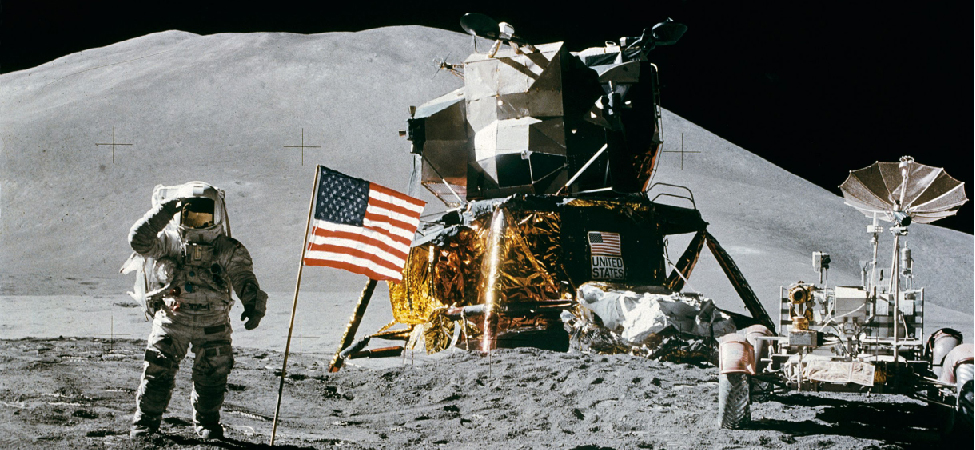
An Inventory
The Sun, a star that is brighter than about 80% of the stars in the Galaxy, is by far the most massive member of the solar system, as shown in [link]. It is an enormous ball about 1.4 million kilometers in diameter, with surface layers of incandescent gas and an interior temperature of millions of degrees. The Sun will be discussed in later chapters as our first, and best-studied, example of a star.
| Mass of Members of the Solar System | |
|---|---|
| Object | Percentage of Total Mass of Solar System |
| Sun | 99.80 |
| Jupiter | 0.10 |
| Comets | 0.0005–0.03 (estimate) |
| All other planets and dwarf planets | 0.04 |
| Moons and rings | 0.00005 |
| Asteroids | 0.000002 (estimate) |
| Cosmic dust | 0.0000001 (estimate) |
[link] also shows that most of the material of the planets is actually concentrated in the largest one, Jupiter, which is more massive than all the rest of the planets combined. Astronomers were able to determine the masses of the planets centuries ago using Kepler’s laws of planetary motion and Newton’s law of gravity to measure the planets’ gravitational effects on one another or on moons that orbit them (see Orbits and Gravity). Today, we make even more precise measurements of their masses by tracking their gravitational effects on the motion of spacecraft that pass near them.
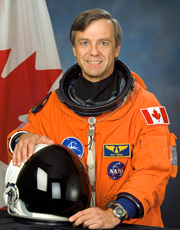
Bob’s first spaceflight was in 1996 during The Life and Microgravity Spacelab Mission (LMS). During the 17 day mission, he was directly involved with 41 experiments which ranged from investigating the effects of space flight on plants and animals to protein crystallization. He followed this with mission specialist training at NASA’s Johnson Space Center and certification as a Flight Engineer for Soyuz spacecraft near Moscow in preparation for a second space journey in 2009. It was a long duration expedition and the first for a Canadian. Bob joined with five other international crew members on the ISS for a total of 188 days.
Dr. Thirsk retired from the CSA in 2012 and for the next two years worked for the Canadian Institute of Health Research before becoming Chancellor of the University of Calgary.
Beside Earth, five other planets were known to the ancients—Mercury, Venus, Mars, Jupiter, and Saturn—and two were discovered after the invention of the telescope: Uranus and Neptune. The eight planets all revolve in the same direction around the Sun. They orbit in approximately the same plane, like cars traveling on concentric tracks on a giant, flat racecourse. Each planet stays in its own “traffic lane,” following a nearly circular orbit about the Sun and obeying the “traffic” laws discovered by Galileo, Kepler, and Newton. Besides these planets, we have also been discovering smaller worlds beyond Neptune that are called trans-Neptunian objects or TNOs (see [link]). The first to be found, in 1930, was Pluto, but others have been discovered during the twenty-first century. One of them, Eris, is about the same size as Pluto and has at least one moon (Pluto has five known moons.) The largest TNOs are also classed as dwarf planets, as is the largest asteroid, Ceres. (Dwarf planets will be discussed further in the chapter on Rings, Moons, and Pluto). To date, more than 1750 of these TNOs have been discovered.
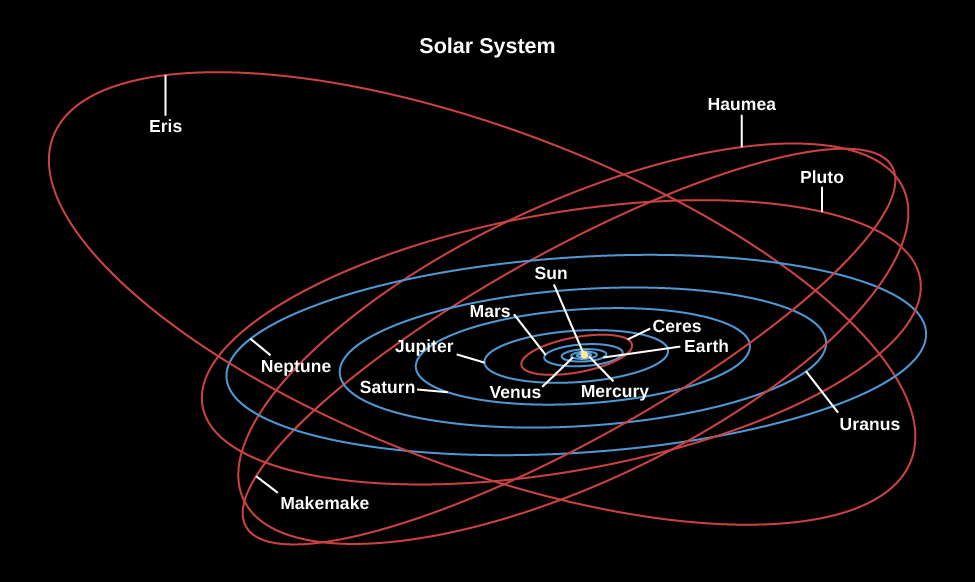
Each of the planets and dwarf planets also rotates (spins) about an axis running through it, and in most cases the direction of rotation is the same as the direction of revolution about the Sun. The exceptions are Venus, which rotates backward very slowly (that is, in a retrograde direction), and Uranus and Pluto, which also have strange rotations, each spinning about an axis tipped nearly on its side. We do not yet know the spin orientations of Eris, Haumea, and Makemake.
The four planets closest to the Sun (Mercury through Mars) are called the inner or terrestrial planets. Often, the Moon is also discussed as a part of this group, bringing the total of terrestrial objects to five. (We generally call Earth’s satellite “the Moon,” with a capital M, and the other satellites “moons,” with lowercase m’s.) The terrestrial planets are relatively small worlds, composed primarily of rock and metal. All of them have solid surfaces that bear the records of their geological history in the forms of craters, mountains, and volcanoes ([link]).
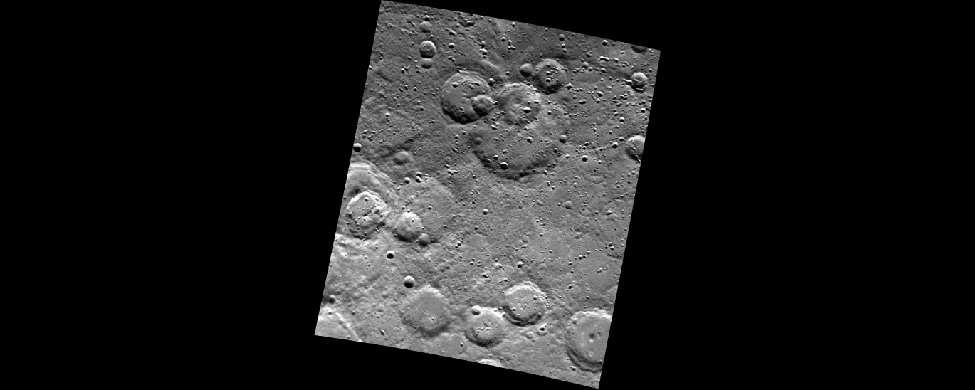
The next four planets (Jupiter through Neptune) are much larger and are composed primarily of lighter ices, liquids, and gases. We call these four the jovian planets (after “Jove,” another name for Jupiter in mythology) or giant planets—a name they richly deserve ([link]). More than 1400 Earths could fit inside Jupiter, for example. These planets do not have solid surfaces on which future explorers might land. They are more like vast, spherical oceans with much smaller, dense cores.
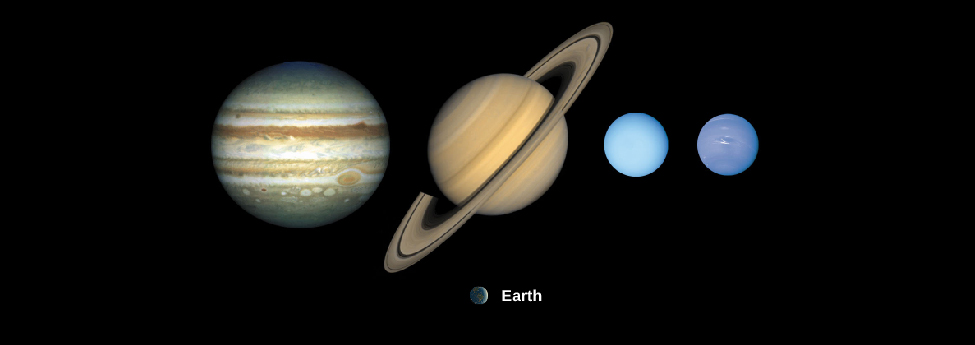
Near the outer edge of the system lies Pluto, which was the first of the distant icy worlds to be discovered beyond Neptune (Pluto was visited by a spacecraft, the NASA New Horizons mission, in 2015 [see [link]]). [link] summarizes some of the main facts about the planets.

| The Planets | |||||
|---|---|---|---|---|---|
| Name | Distance from Sun
(AU)2 |
Revolution Period
(y) |
Diameter
(km) |
Mass
(1023 kg) |
Density
(g/cm3)3 |
| Mercury | 0.39 | 0.24 | 4,878 | 3.3 | 5.4 |
| Venus | 0.72 | 0.62 | 12,120 | 48.7 | 5.2 |
| Earth | 1.00 | 1.00 | 12,756 | 59.8 | 5.5 |
| Mars | 1.52 | 1.88 | 6,787 | 6.4 | 3.9 |
| Jupiter | 5.20 | 11.86 | 142,984 | 18,991 | 1.3 |
| Saturn | 9.54 | 29.46 | 120,536 | 5686 | 0.7 |
| Uranus | 19.18 | 84.07 | 51,118 | 866 | 1.3 |
| Neptune | 30.06 | 164.82 | 49,660 | 1030 | 1.6 |
Let’s compare the densities of several members of the solar system. The density of an object equals its mass divided by its volume. The volume (V) of a sphere (like a planet) is calculated using the equation
where π (the Greek letter pi) has a value of approximately 3.14. Although planets are not perfect spheres, this equation works well enough. The masses and diameters of the planets are given in [link]. For data on selected moons, see Appendix G. Let’s use Saturn’s moon Mimas as our example, with a mass of 4 × 1019 kg and a diameter of approximately 400 km (radius, 200 km = 2 × 105 m).
Solution
The volume of Mimas is
Density is mass divided by volume:
Note that the density of water in these units is 1000 kg/m3, so Mimas must be made mainly of ice, not rock. (Note that the density of Mimas given in Appendix G is 1.2, but the units used there are different. In that table, we give density in units of
g/cm3, for which the density of water equals 1. Can you show, by converting units, that 1 g/cm3 is the same as 1000 kg/m3?)
Check Your Learning
Calculate the average density of our own planet, Earth. Show your work. How does it compare to the density of an ice moon like Mimas? See [link] for data.
For a sphere,
$$\text{density}=\frac{\text{mass}}{\left(\frac{4}{3}\pi\:R^{3}\right)}{\text{kg/m}}^{3}.$$
For Earth, then,
$$\text{density}=\frac{6\phantom{\rule{0.2em}{0ex}}\times\phantom{\rule{0.2em}{0ex}}{10}^{24}\phantom{\rule{0.2em}{0ex}}\text{kg}}{4.2\phantom{\rule{0.2em}{0ex}}\times\phantom{\rule{0.2em}{0ex}}2.6\phantom{\rule{0.2em}{0ex}}\times\phantom{\rule{0.2em}{0ex}}{10}^{20}\phantom{\rule{0.2em}{0ex}}{\text{m}}^{3}}=5.5\phantom{\rule{0.2em}{0ex}}\times\phantom{\rule{0.2em}{0ex}}{10}^{3}\phantom{\rule{0.2em}{0ex}}{\text{kg/m}}^{3}.$$
This density is four to five times greater than Mimas’. In fact, Earth is the densest of the planets.
Smaller Members of the Solar System
Most of the planets are accompanied by one or more moons; only Mercury and Venus move through space alone. There are more than 180 known moons orbiting planets and dwarf planets (see Appendix G for a listing of the larger ones), and undoubtedly many other small ones remain undiscovered. The largest of the moons are as big as small planets and just as interesting. In addition to our Moon, they include the four largest moons of Jupiter (called the Galilean moons, after their discoverer) and the largest moons of Saturn and Neptune (confusingly named Titan and Triton).
Each of the giant planets also has rings made up of countless small bodies ranging in size from mountains to mere grains of dust, all in orbit about the equator of the planet. The bright rings of Saturn are, by far, the easiest to see. They are among the most beautiful sights in the solar system ([link]). But, all four ring systems are interesting to scientists because of their complicated forms, influenced by the pull of the moons that also orbit these giant planets.

The solar system has many other less-conspicuous members. Another group is the asteroids, rocky bodies that orbit the Sun like miniature planets, mostly in the space between Mars and Jupiter (although some do cross the orbits of planets like Earth—see [link]). Most asteroids are remnants of the initial population of the solar system that existed before the planets themselves formed. Some of the smallest moons of the planets, such as the moons of Mars, are very likely captured asteroids.

Another class of small bodies is composed mostly of ice, made of frozen gases such as water, carbon dioxide, and carbon monoxide; these objects are called comets (see [link]). Comets also are remnants from the formation of the solar system, but they were formed and continue (with rare exceptions) to orbit the Sun in distant, cooler regions—stored in a sort of cosmic deep freeze. This is also the realm of the larger icy worlds, called dwarf planets.
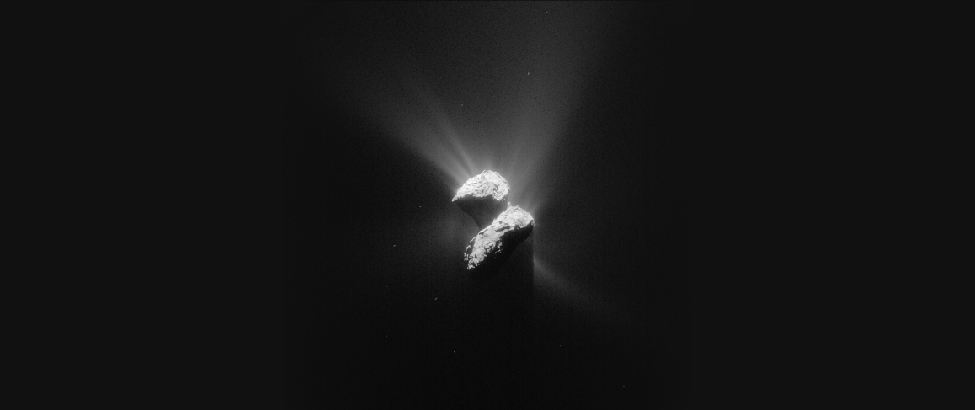
Finally, there are countless grains of broken rock, which we call cosmic dust, scattered throughout the solar system. When these particles enter Earth’s atmosphere (as millions do each day) they burn up, producing a brief flash of light in the night sky known as a meteor (meteors are often referred to as shooting stars). Occasionally, some larger chunk of rocky or metallic material survives its passage through the atmosphere and lands on Earth. Any piece that strikes the ground is known as a meteorite. (You can see meteorites on display in many natural history museums and can sometimes even purchase pieces of them from gem and mineral dealers.)
The best-known astronomer in the world during the 1970s and 1980s, Carl Sagan devoted most of his professional career to studying the planets and considerable energy to raising public awareness of what we can learn from exploring the solar system (see [link]). Born in Brooklyn, New York, in 1934, Sagan became interested in astronomy as a youngster; he also credits science fiction stories for sustaining his fascination with what’s out in the universe.

In the early 1960s, when many scientists still thought Venus might turn out to be a hospitable place, Sagan calculated that the thick atmosphere of Venus could act like a giant greenhouse, keeping the heat in and raising the temperature enormously. He showed that the seasonal changes astronomers had seen on Mars were caused, not by vegetation, but by wind-blown dust. He was a member of the scientific teams for many of the robotic missions that explored the solar system and was instrumental in getting NASA to put a message-bearing plaque aboard the Pioneer spacecraft, as well as audio-video records on the Voyager spacecraft—all of them destined to leave our solar system entirely and send these little bits of Earth technology out among the stars.
To encourage public interest and public support of planetary exploration, Sagan helped found The Planetary Society, now the largest space-interest organization in the world. He was a tireless and eloquent advocate of the need to study the solar system close-up and the value of learning about other worlds in order to take better care of our own.
Sagan simulated conditions on early Earth to demonstrate how some of life’s fundamental building blocks might have formed from the “primordial soup” of natural compounds on our planet. In addition, he and his colleagues developed computer models showing the consequences of nuclear war for Earth would be even more devastating than anyone had thought (this is now called the nuclear winter hypothesis) and demonstrating some of the serious consequences of continued pollution of our atmosphere.
Sagan was perhaps best known, however, as a brilliant popularizer of astronomy and the author of many books on science, including the best-selling Cosmos, and several evocative tributes to solar system exploration such as The Cosmic Connection and Pale Blue Dot. His book The Demon Haunted World, completed just before his death in 1996, is perhaps the best antidote to fuzzy thinking about pseudo-science and irrationality in print today. An intriguing science fiction novel he wrote, titled Contact, which became a successful film as well, is still recommended by many science instructors as a scenario for making contact with life elsewhere that is much more reasonable than most science fiction.
Sagan was a master, too, of the television medium. His 13-part public television series, Cosmos, was seen by an estimated 500 million people in 60 countries and has become one of the most-watched series in the history of public broadcasting. A few astronomers scoffed at a scientist who spent so much time in the public eye, but it is probably fair to say that Sagan’s enthusiasm and skill as an explainer won more friends for the science of astronomy than anyone or anything else in the second half of the twentieth century.
In the two decades since Sagan’s death, no other scientist has achieved the same level of public recognition. Perhaps closest is the director of the Hayden Planetarium, Neil deGrasse Tyson, who followed in Sagan’s footsteps by making an updated version of the Cosmos program in 2014. Tyson is quick to point out that Sagan was his inspiration to become a scientist, telling how Sagan invited him to visit for a day at Cornell when he was a high school student looking for a career. However, the media environment has fragmented a great deal since Sagan’s time. It is interesting to speculate whether Sagan could have adapted his communication style to the world of cable television, Twitter, Facebook, and podcasts.
A Scale Model of the Solar System
Astronomy often deals with dimensions and distances that far exceed our ordinary experience. What does 1.4 billion kilometers—the distance from the Sun to Saturn—really mean to anyone? It can be helpful to visualize such large systems in terms of a scale model.
In our imaginations, let us build a scale model of the solar system, adopting a scale factor of 1 billion (109)—that is, reducing the actual solar system by dividing every dimension by a factor of 109. Earth, then, has a diameter of 1.3 centimeters, about the size of a grape. The Moon is a pea orbiting this at a distance of 40 centimeters, or a little more than a foot away. The Earth-Moon system fits into a standard backpack.
In this model, the Sun is nearly 1.5 meters in diameter, about the average height of an adult, and our Earth is at a distance of 150 meters—about one city block—from the Sun. Jupiter is five blocks away from the Sun, and its diameter is 15 centimeters, about the size of a very large grapefruit. Saturn is 10 blocks from the Sun; Uranus, 20 blocks; and Neptune, 30 blocks. Pluto, with a distance that varies quite a bit during its 249-year orbit, is currently just beyond 30 blocks and getting farther with time. Most of the moons of the outer solar system are the sizes of various kinds of seeds orbiting the grapefruit, oranges, and lemons that represent the outer planets.
In our scale model, a human is reduced to the dimensions of a single atom, and cars and spacecraft to the size of molecules. Sending the Voyager spacecraft to Neptune involves navigating a single molecule from the Earth–grape toward a lemon 5 kilometers away with an accuracy equivalent to the width of a thread in a spider’s web.
If that model represents the solar system, where would the nearest stars be? If we keep the same scale, the closest stars would be tens of thousands of kilometers away. If you built this scale model in the city where you live, you would have to place the representations of these stars on the other side of Earth or beyond.
By the way, model solar systems like the one we just presented have been built in cities throughout the world. In Sweden, for example, Stockholm’s huge Globe Arena has become a model for the Sun, and Pluto is represented by a 12-centimeter sculpture in the small town of Delsbo, 300 kilometers away. Another model solar system is in Washington on the Mall between the White House and Congress (perhaps proving they are worlds apart?).
We humans just don’t feel comfortable until something has a name. Types of butterflies, new elements, and the mountains of Venus all need names for us to feel we are acquainted with them. How do we give names to objects and features in the solar system?
Planets and moons are named after gods and heroes in Greek and Roman mythology (with a few exceptions among the moons of Uranus, which have names drawn from English literature). When William Herschel, a German immigrant to England, first discovered the planet we now call Uranus, he wanted to name it Georgium Sidus (George’s star) after King George III of his adopted country. This caused such an outcry among astronomers in other nations, however, that the classic tradition was upheld—and has been maintained ever since. Luckily, there were a lot of minor gods in the ancient pantheon, so plenty of names are left for the many small moons we are discovering around the giant planets. (Appendix G lists the larger moons).
Comets are often named after their discoverers (offering an extra incentive to comet hunters). Asteroids are named by their discoverers after just about anyone or anything they want. Recently, asteroid names have been used to recognize people who have made significant contributions to astronomy, including the three original authors of this book.
That was pretty much all the naming that was needed while our study of the solar system was confined to Earth. But now, our spacecraft have surveyed and photographed many worlds in great detail, and each world has a host of features that also need names. To make sure that naming things in space remains multinational, rational, and somewhat dignified, astronomers have given the responsibility of approving names to a special committee of the International Astronomical Union (IAU), the body that includes scientists from every country that does astronomy.
This IAU committee has developed a set of rules for naming features on other worlds. For example, craters on Venus are named for women who have made significant contributions to human knowledge and welfare. Volcanic features on Jupiter’s moon Io, which is in a constant state of volcanic activity, are named after gods of fire and thunder from the mythologies of many cultures. Craters on Mercury commemorate famous novelists, playwrights, artists, and composers. On Saturn’s moon Tethys, all the features are named after characters and places in Homer’s great epic poem, The Odyssey. As we explore further, it may well turn out that more places in the solar system need names than Earth history can provide. Perhaps by then, explorers and settlers on these worlds will be ready to develop their own names for the places they may (if but for a while) call home.
You may be surprised to know that the meaning of the word planet has recently become controversial because we have discovered many other planetary systems that don’t look very much like our own. Even within our solar system, the planets differ greatly in size and chemical properties. The biggest dispute concerns Pluto, which is much smaller than the other eight major planets. The category of dwarf planet was invented to include Pluto and similar icy objects beyond Neptune. But is a dwarf planet also a planet? Logically, it should be, but even this simple issue of grammar has been the subject of heated debate among both astronomers and the general public.
Key Concepts and Summary
Our solar system currently consists of the Sun, eight planets, five dwarf planets, nearly 200 known moons, and a host of smaller objects. The planets can be divided into two groups: the inner terrestrial planets and the outer giant planets. Pluto, Eris, Haumea, and Makemake do not fit into either category; as icy dwarf planets, they exist in an ice realm on the fringes of the main planetary system. The giant planets are composed mostly of liquids and gases. Smaller members of the solar system include asteroids (including the dwarf planet Ceres), which are rocky and metallic objects found mostly between Mars and Jupiter; comets, which are made mostly of frozen gases and generally orbit far from the Sun; and countless smaller grains of cosmic dust. When a meteor survives its passage through our atmosphere and falls to Earth, we call it a meteorite.
Footnotes
- 1 The generic term for a group of planets and other bodies circling a star is planetary system. Ours is called the solar system because our Sun is sometimes called Sol. Strictly speaking, then, there is only one solar system; planets orbiting other stars are in planetary systems.
- 2 An AU (or astronomical unit) is the distance from Earth to the Sun.
- 3 We give densities in units where the density of water is 1 g/cm3. To get densities in units of kg/m3, multiply the given value by 1000.
Glossary
- asteroid
- a stony or metallic object orbiting the Sun that is smaller than a major planet but that shows no evidence of an atmosphere or of other types of activity associated with comets
- comet
- a small body of icy and dusty matter that revolves about the Sun; when a comet comes near the Sun, some of its material vaporizes, forming a large head of tenuous gas and often a tail
- giant planet
- any of the planets Jupiter, Saturn, Uranus, and Neptune in our solar system, or planets of roughly that mass and composition in other planetary systems
- meteor
- a small piece of solid matter that enters Earth’s atmosphere and burns up, popularly called a shooting star because it is seen as a small flash of light
- meteorite
- a portion of a meteor that survives passage through an atmosphere and strikes the ground
- terrestrial planet
- any of the planets Mercury, Venus, Earth, or Mars; sometimes the Moon is included in the list

